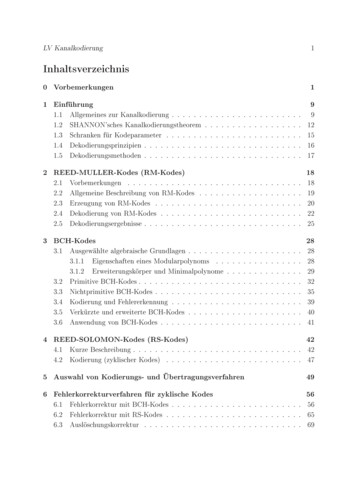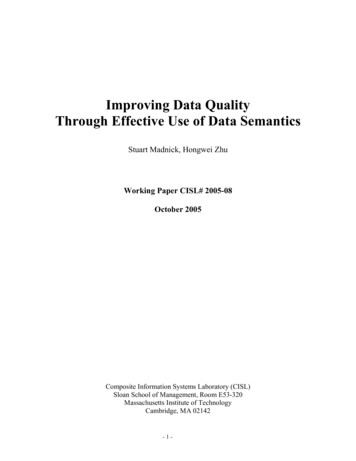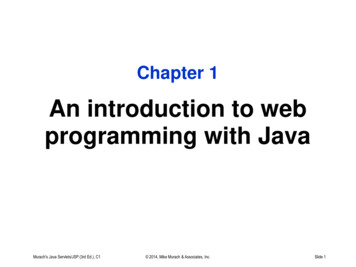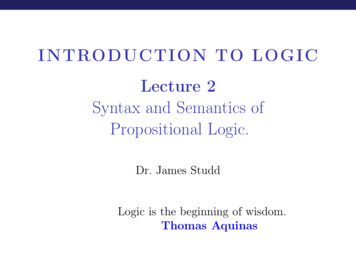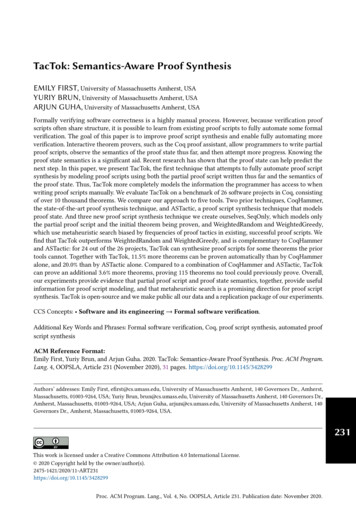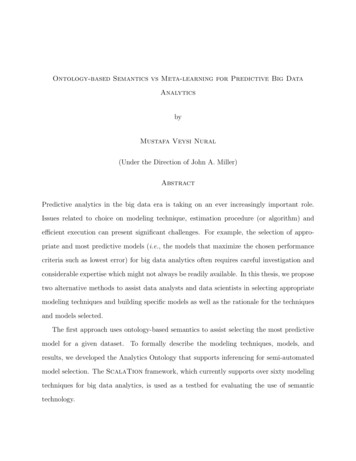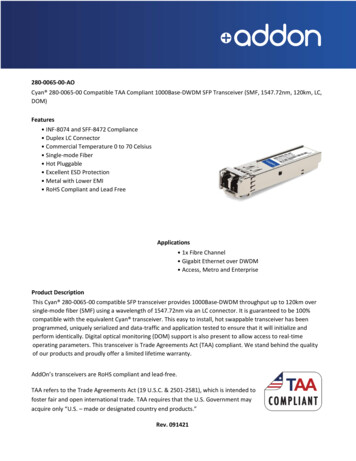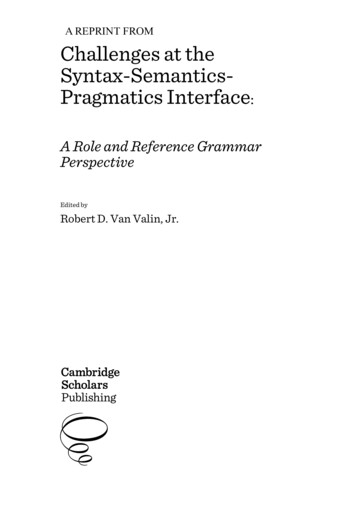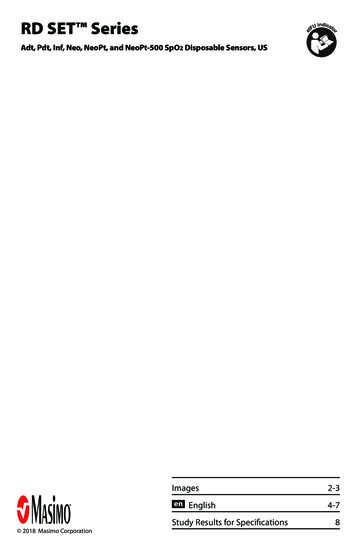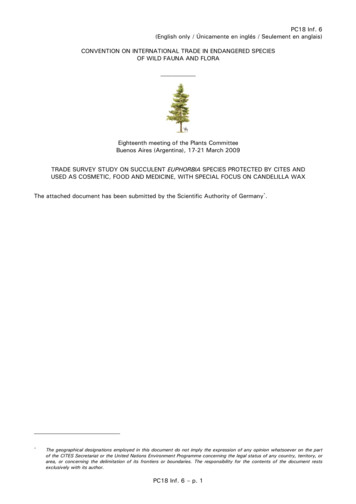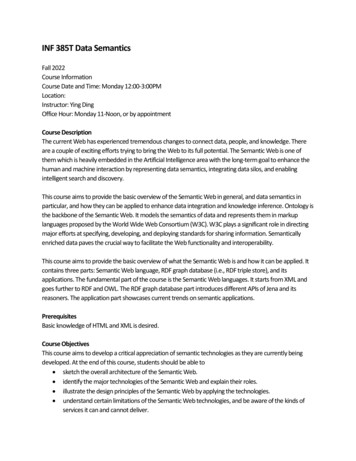
Transcription
INF 385T Data SemanticsFall 2022Course InformationCourse Date and Time: Monday 12:00-3:00PMLocation:Instructor: Ying DingOffice Hour: Monday 11-Noon, or by appointmentCourse DescriptionThe current Web has experienced tremendous changes to connect data, people, and knowledge. Thereare a couple of exciting efforts trying to bring the Web to its full potential. The Semantic Web is one ofthem which is heavily embedded in the Artificial Intelligence area with the long-term goal to enhance thehuman and machine interaction by representing data semantics, integrating data silos, and enablingintelligent search and discovery.This course aims to provide the basic overview of the Semantic Web in general, and data semantics inparticular, and how they can be applied to enhance data integration and knowledge inference. Ontology isthe backbone of the Semantic Web. It models the semantics of data and represents them in markuplanguages proposed by the World Wide Web Consortium (W3C). W3C plays a significant role in directingmajor efforts at specifying, developing, and deploying standards for sharing information. Semanticallyenriched data paves the crucial way to facilitate the Web functionality and interoperability.This course aims to provide the basic overview of what the Semantic Web is and how it can be applied. Itcontains three parts: Semantic Web language, RDF graph database (i.e., RDF triple store), and itsapplications. The fundamental part of the course is the Semantic Web languages. It starts from XML andgoes further to RDF and OWL. The RDF graph database part introduces different APIs of Jena and itsreasoners. The application part showcases current trends on semantic applications.PrerequisitesBasic knowledge of HTML and XML is desired.Course ObjectivesThis course aims to develop a critical appreciation of semantic technologies as they are currently beingdeveloped. At the end of this course, students should be able to sketch the overall architecture of the Semantic Web. identify the major technologies of the Semantic Web and explain their roles. illustrate the design principles of the Semantic Web by applying the technologies. understand certain limitations of the Semantic Web technologies, and be aware of the kinds ofservices it can and cannot deliver.
course aims are achieved through: Lectures covers basic knowledge of the Semantic Web Projects applying semantic technologies to concrete problems of information delivery and use Assignments of practicing and utilizing key semantic technologiesCourse MaterialsThis course is developed mainly based on materials from w3schools and W3CRecommended books for this course: Allemang, D., & Hendler, J. (2011). Semantic Web for the working ontologist. 2nd Edition,Morgan&Kaufmann Publisher. [ISBN:978-0-12-385965-5] Heath, T., & Bizer, C. (2011). Linked Data: Evolving the Web into a Global Data Space.Morgan&Claypool Publisher. (http://linkeddatabook.com/editions/1.0/) Daconts, M.C., Orbst, L.J., & Smith, K.T. (2003). The Semantic Web: A Guide to the Future of XML,Web Services, and Knowledge Management. New York: Wiley. [ISBN: 0-471-43257-1] Antoniou, G., & van Harmelen, F. (2004). A Semantic Web Primer. Cambridge, MA: MIT Press.[ISBN: 0-262-01210-3] Powers, S. (2003). Practical RDF. Sebastopol, CA: O'Reilly. [ISBN: 0-596-00263-7] Russell, S., & Norvig, P. (2003). Artificial Intelligence: A Modern Approach. 2nd Edition. PearsonEducation.Software Oxygen XML editor Protege Ontology editor: available at protege website Jena 4 Instructions on installing Java and Jena on Windows or MacDataset XML dataseto https://catalog.data.gov/dataset?res format XMLo https://www.nlm.nih.gov/databases/dtd/index.htmlo https://www.nlm.nih.gov/bsd/licensee/elements descriptions.htmlRDF dataseto https://www.bl.uk/collection-metadata/downloadso https://id.nlm.nih.gov/mesh/o https://catalog.data.gov/dataset?res format RDF& res format limit 0o https://id.loc.gov/o https://makg.org/rdf-dumps/RDF Schemao onversion.htmlOWL
o https://protegewiki.stanford.edu/wiki/Protege Ontology LibraryOntologyo http://www.obofoundry.org/o https://protegewiki.stanford.edu/wiki/Protege Ontology Libraryo https://www.bioontology.org/o https://www.w3.org/wiki/Good Ontologieso http://www.loc.gov/standards/premis/ontology/o https://www.loc.gov/standards/mods/rdf/Sparql:o https://id.nlm.nih.gov/mesh/queryo http://data.nobelprize.org/snorql/? ga 78o Running Sparql on Python: chedule (tentative)DateLectureSemantic Web LanguageL1IntroductionL2DTDL3XML SchemaL4L5XPath, XQueryRDFL6RDF Schema, OWLLab/TutorialNotesXML, looking at the examples and writeyour first XML file.work on your first DTD example, workingon DTD exercisework on your first XML Schema example,work on XML Schema exercise.work on XPath XQuery exerciseTurtle, work on your RDF example, workon RDF exerciseLinked Open Data, work on RDFS exercise,OWL exercise.docKnowing eachotherForm a groupProtege LabProtege Lab, finish pizza.owlSelect one ontology and implement it inProtégé: ns/dublin-core/dcmi-terms/)RDF Tutorial DueGroup ProjectWork on yourassignmentSet up Eclips and set up Apache Jena 4 onEclipseJena Reasoner APIJena Sparql APIProtégé TutorialDueGroup ProjectWork on yourassignmentJena RDF API DueGroup ProjectForm a groupForm a groupXML Tutorial DueGroup Project(send title andteam info to me)OntologyL7L8L9ontologyProtégé LabGood ontologies(https://www.w3.org/wiki/Good Ontologies)Jena – RDF Triple StoreL10Jena RDF APIL11L12L13L14Jena Ontology APISparql, Sparql byExampleJena ExamplesData SearchJena Examplesrun data search tutorial by yourself
L15Group projectpresentationL16Group project presentationJena Example DueFinal Group Project Report dueAssignments and GradingIndividual Assignments (50%)1. XML Tutorial (10%): Please show one XML example, with its schema in D2D and XML Schema, also add5 queries using XPath or XQuery. Please use Oxygen to show all the XML files are well-formed andvalidated (powerpoint slides showing XML file, D2D, and XML Schema, XQuery, Oxygen screenshots, andXML/D2D/XML Schema files)2. RDF Tutorial (10%): Please show one RDF file, with its schema written in RDF Schema, show thevalidation and generated triples (powerpoint slides showing RDF file, RDF Schema file, screenshots withvalidation and generated triples, and RDF/RDF Schema files)3. Protégé Tutorial (10%): Please develop a tutorial on using Protégé to represent one ontology(powerpoint slides showing steps, final OWL file)4. Jena RDF API (10%): Use RDF API to read one RDF file in and do some basic searches (powerpointslides, code).5. Jena Example (10%): Develop a Jena example (powerpoint slides, code).Group Project (40%): Form a group to work on the following topics (select one): to develop one tutorial to introduce a graph deep learning method (e.g., explain the method,show the details on how the method can be applied in one graph, and show the results.Examples: node2vec, TransE, GraphSage, Heterogeneous Graph Transformer)to develop one tutorial to apply semantic web technologies to solve a specific issue (e.g., libraryscience, healthcare, search/reason on ontology and RDF data)to write a survey article on the latest research development of semantic web technologies andits applications (e.g., ISWC, WWW)to work on a research article (no need to finish this by the end of the semester, talk toinstructor)Output:o Tutorial: a 3-5 page report (aiming for a workshop paper), powerpoint slides, code, and5-10mins of video (assuming that you will teach it to other students), presentationo Survey/research: a 10-15 page report (aiming for a conference paper), powerpointslides, 5-10mins of video, presentationClass discussion, participation, and final presentation (10%)Grading ScaleThis class employs a plus/minus grading system. For more information on this system, please consult theUniversity’s General Information Catalog. Below is the grade scale the University employs and which will
be used in this class:Meets major requirementDoes not meet requirementGradeAAB BBC CGradeCD DDFPoints 3.00-66.9960.00-62.99 60.00Land AcknowledgementWe acknowledge that the iSchool sits on indigenous land. We would like to acknowledge that we aremeeting on Indigenous land. Moreover, we would like to acknowledge and pay our respects to theCarrizo & Comecrudo, Coahuiltecan, Caddo, Tonkawa, Comanche, Lipan Apache, Alabama-Coushatta,Kickapoo, Tigua Pueblo, and all the American Indian and Indigenous Peoples and communities who havebeen or have become a part of these lands and territories in Texas, here on Turtle Island.Title IXTitle IX and Texas SB 212 Reporting requirements: Title IX is a federal law that protects against sex andgender-based discrimination, sexual harassment, sexual assault, unprofessional or inappropriateconduct of a sexual nature, dating/domestic violence and stalking at federally funded educationalinstitutions. UT Austin is committed to fostering a learning and working environment free fromdiscrimination in all its forms. For more information about reporting options and resources, visithttp://www.titleix.utexas.edu/, contact the Title IX Office via email at titleix@austin.utexas.edu, or call512-471-0419.University Resources for StudentsThe university has numerous resources for students for your learning, use these to help you succeed inyour classes The University Writing Center: The University Writing Center offers free, individualized, experthelp with writing for any UT student, by appointment or on a drop-in basis. Consultants helpstudents develop strategies to improve their writing. The assistance we provide is intended tofoster students’ resourcefulness and self-reliance. http://uwc.utexas.edu/Counseling and Mental Health Center: The Counseling and Mental Health Center (CMHC)provides counseling, psychiatric, consultation, and prevention services that facilitate students'academic and life goals and enhance their personal growth and well-being.http://cmhc.utexas.edu/Basic Needs Security: Any student who faces challenges of affording groceries or accessingsufficient food to eat every day, or who lacks a safe and stable place to live, and believe this mayaffect their performance in the course, is encouraged to contact the Office of the Dean ofStudents – Student Emergency Services (SES) for support. Please notify the instructor if you are
comfortable doing so and I will make efforts to provide any resources that I may possess to helpyou navigate issues of food insecurity or residential displacement.SES Concerns and ency/concernsemergencies.phpSES Food Pantry: phpSES Confidential Advocacy and /advocacysupport.phpStudent Emergency Services: http://deanofstudents.utexas.edu/emergency/ITS: Need help with technology? http://www.utexas.edu/its/Libraries: Need help searching for information? http://www.lib.utexas.edu/Canvas: Canvas help is available 24/7 ges/student-tutorialsBehavior Concerns Advice Line (BCAL): If you are worried about someone who is actingdifferently, you may use the Behavior Concerns Advice Line to discuss by phone your concernsabout another individual’s behavior. This service is provided through a partnership among theOffice of the Dean of Students, the Counseling and Mental Health Center (CMHC), the EmployeeAssistance Program (EAP), and The University of Texas Police Department (UTPD). Call 512-2325050 or visit http://www.utexas.edu/safety/bcal.University of Texas Core Values and Honor Code: The core values of The University of Texas at Austin arelearning, discovery, freedom, leadership, individual opportunity, and responsibility. Each member of theuniversity is expected to uphold these values through integrity, honesty, trust, fairness, and respecttoward peers and community. As a student of the University of Texas at Austin, I shall abide by πthecore values of the University and uphold academic integrity.COVID InformationPlease visit https://protect.utexas.edu
The Semantic Web is one of . Semantic Web for the working ontologist. 2nd Edition, Morgan&Kaufmann Publisher. [ISBN:978--12-385965-5] Heath, T., & Bizer, C. (2011). Linked Data: Evolving the Web into a Global Data Space. . L2 DTD work on your first DTD example, working on DTD exercise Form a group
